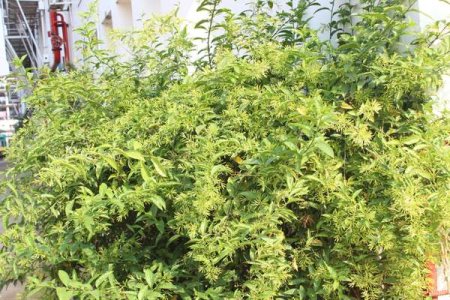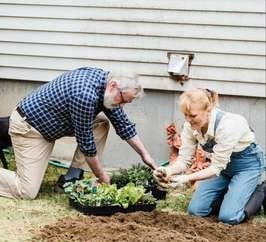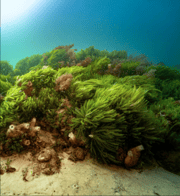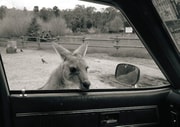Is This Plant in Your Backyard Threatening Your Brain Health? Aussie Homes Face Invasive Nightmare!
By
Maan
- Replies 4
Gardening is a beloved pastime for many of us, offering a chance to cultivate beauty and tranquility in our own backyards. However, amidst the roses and gardenias, there lurks a less welcome guest that could be more than just an eyesore—it could be a threat to your health.
The plant in question is none other than the aggressive and invasive ‘monstrosity’ known as the Giant Hogweed (Heracleum mantegazzianum). According to reports, the sap of the Giant Hogweed contains toxic compounds that can cause phytophotodermatitis, leading to severe skin burns, long-lasting scars, and if it comes into contact with the eyes, blindness.
This towering plant, which can reach up to 5 meters in height, is not just a challenge for gardeners due to its rapid spread and resilience, but it also poses a serious health risk. In fact; recent studies have suggested that exposure to this plant may also be linked to brain dysfunction.
The Giant Hogweed, originally from the Caucasus region, was introduced to Australia as an ornamental plant. Its impressive size and large, umbrella-shaped flower heads may have seemed attractive at first, but it quickly became apparent that this plant does not play well with others. It spreads rapidly, outcompeting native flora and taking over large swathes of land, which can lead to a decrease in biodiversity.
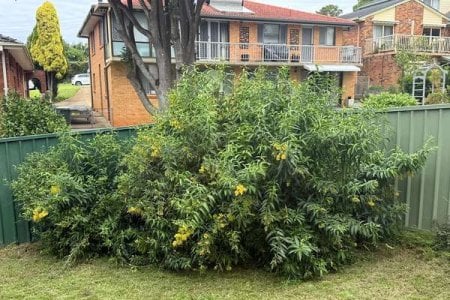
The plant’s sap is phototoxic, meaning that when it comes into contact with skin and is then exposed to sunlight, it can cause severe skin inflammation. The resulting blisters and burns can be excruciatingly painful and may take a long time to heal. In some cases, the skin may remain sensitive to UV light for many years.
But physical injuries are not the only concern. There is growing evidence to suggest that the toxins present in the Giant Hogweed may have neurological effects as well. While the exact mechanisms are not yet fully understood, it is believed that the toxins may cause inflammation or oxidative stress in the brain, potentially leading to symptoms of brain dysfunction such as headaches, dizziness, and even problems with memory and concentration.
The presence of this invasive plant in Australian yards is a cause for concern, not only for individual health but also for the environment. It’s crucial for homeowners to be able to identify the Giant Hogweed and to understand the risks it poses. The plant has deeply incised leaves and a thick, bristly stem that is often spotted with purple. Its white flower clusters can look deceptively charming, but it’s important not to be fooled by its appearance.
If you suspect that you have Giant Hogweed on your property, it’s essential to handle it with extreme caution. Do not attempt to remove it without proper protective gear, as even a small amount of sap can cause injury. It’s advisable to seek professional help for removal, as improper handling can lead to further spread.
For those who love to garden, the threat of invasive species like the Giant Hogweed is a stark reminder of the importance of choosing plants wisely and being aware of the potential impacts on our health and environment. It’s always best to opt for native species that support local ecosystems and pose no threat to human health.

We at the Seniors Discount Club urge you to take a moment to inspect your garden for any unwelcome invaders. If you come across the Giant Hogweed or any other suspicious plant, contact your local council or a professional weed control service for advice on safe removal.
Remember, a healthy garden is not just about the beauty we can see—it’s also about the unseen balance that supports our wellbeing and that of the natural world around us.
Have you encountered any invasive plants in your garden? What measures have you taken to address the issue? Share your experiences in the comments below and help your fellow gardeners stay informed and safe.
The plant in question is none other than the aggressive and invasive ‘monstrosity’ known as the Giant Hogweed (Heracleum mantegazzianum). According to reports, the sap of the Giant Hogweed contains toxic compounds that can cause phytophotodermatitis, leading to severe skin burns, long-lasting scars, and if it comes into contact with the eyes, blindness.
This towering plant, which can reach up to 5 meters in height, is not just a challenge for gardeners due to its rapid spread and resilience, but it also poses a serious health risk. In fact; recent studies have suggested that exposure to this plant may also be linked to brain dysfunction.
A Welcome Visitor That Turned Into a Nightmare
The Giant Hogweed, originally from the Caucasus region, was introduced to Australia as an ornamental plant. Its impressive size and large, umbrella-shaped flower heads may have seemed attractive at first, but it quickly became apparent that this plant does not play well with others. It spreads rapidly, outcompeting native flora and taking over large swathes of land, which can lead to a decrease in biodiversity.

What seemed like an ornamental beauty quickly turned into a garden villain—how the Giant Hogweed threatens Australia’s biodiversity. Image source: Michelle Ingrham
The Hidden Dangers: Skin and Brain Health
The plant’s sap is phototoxic, meaning that when it comes into contact with skin and is then exposed to sunlight, it can cause severe skin inflammation. The resulting blisters and burns can be excruciatingly painful and may take a long time to heal. In some cases, the skin may remain sensitive to UV light for many years.
But physical injuries are not the only concern. There is growing evidence to suggest that the toxins present in the Giant Hogweed may have neurological effects as well. While the exact mechanisms are not yet fully understood, it is believed that the toxins may cause inflammation or oxidative stress in the brain, potentially leading to symptoms of brain dysfunction such as headaches, dizziness, and even problems with memory and concentration.
Identifying the Giant Hogweed in Your Garden
The presence of this invasive plant in Australian yards is a cause for concern, not only for individual health but also for the environment. It’s crucial for homeowners to be able to identify the Giant Hogweed and to understand the risks it poses. The plant has deeply incised leaves and a thick, bristly stem that is often spotted with purple. Its white flower clusters can look deceptively charming, but it’s important not to be fooled by its appearance.
What to Do If You Find Giant Hogweed
If you suspect that you have Giant Hogweed on your property, it’s essential to handle it with extreme caution. Do not attempt to remove it without proper protective gear, as even a small amount of sap can cause injury. It’s advisable to seek professional help for removal, as improper handling can lead to further spread.
Choose Wisely: Opt for Native Species
For those who love to garden, the threat of invasive species like the Giant Hogweed is a stark reminder of the importance of choosing plants wisely and being aware of the potential impacts on our health and environment. It’s always best to opt for native species that support local ecosystems and pose no threat to human health.
Key Takeaways
- Take the time to check your garden for any invasive plants like Giant Hogweed to protect both your health and the environment.
- Be aware of plants like Giant Hogweed, which can cause serious skin burns and neurological issues if not handled properly.
- If you discover any suspicious plants, it's important to contact your local council or a professional weed control service to ensure safe removal.
- Early detection and proper handling of invasive plants are crucial in preventing their spread and minimizing risks to your health and the surrounding ecosystem.
We at the Seniors Discount Club urge you to take a moment to inspect your garden for any unwelcome invaders. If you come across the Giant Hogweed or any other suspicious plant, contact your local council or a professional weed control service for advice on safe removal.
Remember, a healthy garden is not just about the beauty we can see—it’s also about the unseen balance that supports our wellbeing and that of the natural world around us.
Have you encountered any invasive plants in your garden? What measures have you taken to address the issue? Share your experiences in the comments below and help your fellow gardeners stay informed and safe.

